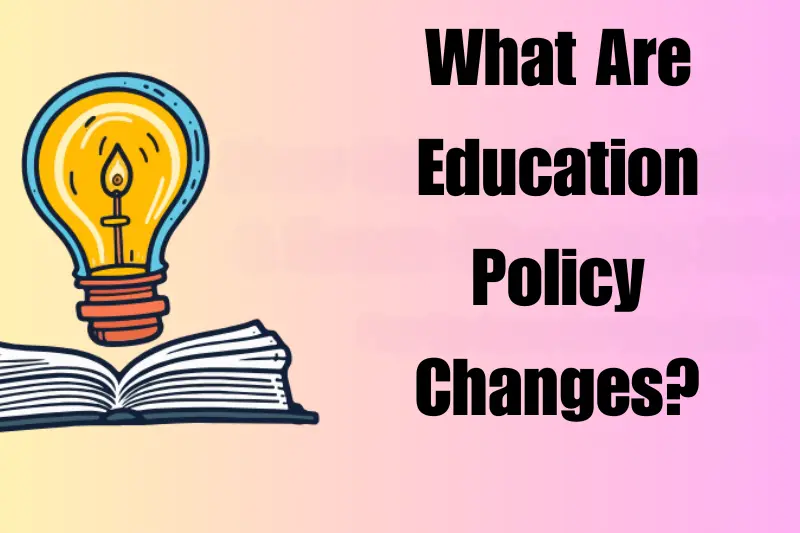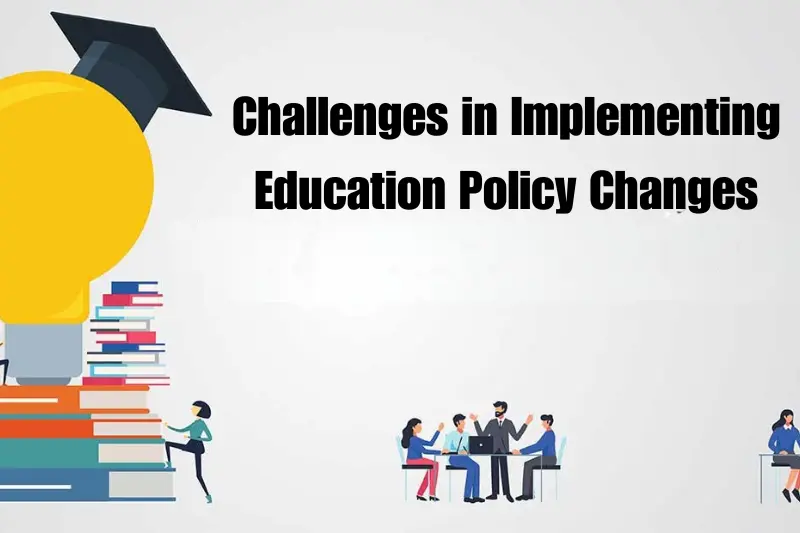In today’s rapidly evolving world, Education Policy Changes are at the heart of reshaping how societies prepare future generations. As nations strive to meet the demands of the 21st century, educational reforms have become a crucial mechanism to promote innovation, inclusion, and quality learning.
This article provides a complete breakdown of what education policy changes are, why they matter, how they are being implemented globally, and what challenges and opportunities lie ahead.
📘 1. What Are Education Policy Changes?

Education Policy Changes refer to any modifications, updates, or overhauls in the laws, regulations, and guidelines that govern the education system. These changes are often introduced by governments or educational authorities to:
- Improve learning outcomes
- Incorporate technology into the classroom
- Address inequalities in education
- Align with economic and workforce needs
- Foster critical thinking, creativity, and global citizenship
Whether it involves altering school curricula, rethinking assessment models, or promoting digital education, education policy changes are integral to educational evolution.
You may also like to read this:
10 Memory Improvement Tips For Students To Remember More
2025 School And College News: What’s New In Education
15 Note-Taking Strategies For Students To Boost Learning
Create An Effective Study Schedule Planner For Results
Latest Education Updates – What’s Changing In 2025
💡 2. Why Education Policy Changes Are Necessary
Education systems globally are under pressure to respond to a range of social, technological, and economic factors. Here’s why Education Policy Changes are essential:
a. Rapid Technological Advancements
With the rise of AI, robotics, and the internet of things (IoT), the traditional classroom is transforming. Education policy changes help schools and universities incorporate coding, digital literacy, and STEM learning.
b. Inequality in Access
Disparities between urban and rural schools, rich and poor students, and access to digital tools necessitate inclusive policies.
c. Globalization
As the world becomes interconnected, students need to develop intercultural understanding and communication skills.
d. Pandemic Lessons
The COVID-19 pandemic emphasized the importance of remote learning infrastructure and flexible learning paths.
🌍 3. Major Education Policy Changes Around the World
🔹 India – National Education Policy (NEP) 2020
NEP 2020 is a landmark in India’s education reform landscape. Key features of this education policy change include:
- Introduction of a new 5+3+3+4 structure
- Emphasis on mother tongue/local language instruction up to Grade 5
- Skill-based and experiential learning
- Reduction of curriculum content
- Focus on teacher training and digital infrastructure
🔹 United States – Every Student Succeeds Act (ESSA)
ESSA replaced the No Child Left Behind Act and gave more autonomy to states to set education goals, implement standards, and measure school performance.
🔹 Finland – Holistic Education Reforms
Finland’s education policy focuses on:
- No standardized tests
- Less homework
- Equal opportunities
- Emphasis on student happiness and mental health
🔹 Kenya – Competency-Based Curriculum (CBC)
Kenya’s CBC reform shifts the focus from rote memorization to skill development, creativity, and continuous assessment.
🔹 UNESCO’s SDG 4 – Global Commitment to Quality Education
The United Nations Sustainable Development Goal 4 commits to “ensure inclusive and equitable quality education and promote lifelong learning opportunities for all” by 2030.
👥 4. Impact of Education Policy Changes on Stakeholders
🧒 Students
- Learn with more flexibility and relevance
- Gain practical skills for the real world
- Access to inclusive and technology-driven education
👩🏫 Teachers
- Need for continuous professional development
- Shift from traditional teaching to facilitating active learning
- More autonomy and accountability
🏫 Schools and Institutions
- Infrastructure and curriculum upgrades
- Emphasis on quality assurance and digital transformation
- Engagement with communities and parents
👪 Parents
- Greater involvement in children’s education
- Need to adapt to changes in homework, assessment, and communication with schools
⚠️ 5. Challenges in Implementing Education Policy Changes

Despite the promise of improvement, education policy changes face several implementation barriers:
a. Insufficient Funding
Reforms often demand significant investment in training, infrastructure, and digital tools.
b. Teacher Shortage
Many countries lack trained educators to implement new policies effectively.
c. Digital Divide
In rural and underprivileged areas, lack of internet access and devices is a major hurdle.
d. Resistance to Change
Teachers, administrators, and even parents may be resistant due to a lack of awareness or support.
e. Policy-Implementation Gap
Well-designed policies often falter at the ground level due to poor execution, lack of accountability, or bureaucracy.
📚 6. Success Stories of Education Policy Changes
✅ Finland
Widely regarded as the gold standard, Finland’s education policies emphasize equity, minimal testing, and student-centered learning.
✅ Singapore
Education policy changes in Singapore have led to an efficient, skills-based education system emphasizing problem-solving and innovation.
✅ Uruguay’s Plan Ceibal
One of the world’s earliest nationwide digital education programs, providing every student with a laptop and free internet access.
🔮 7. The Future of Education Policy Changes
Looking forward, education policy changes will likely address:
- AI and Machine Learning Integration
- Climate Education and sustainability awareness
- Emotional Intelligence and Mental Health Support
- Micro-credentialing and Lifelong Learning Paths
- Global Collaboration in Curriculum Development
Future education policies must be agile, inclusive, and data-driven to effectively prepare students for a complex, uncertain world.
📝 Conclusion
Education Policy Changes are more than administrative reforms—they are transformative actions that shape the future of learning. As the global landscape continues to evolve, these policy changes must ensure equitable access, promote innovation, and prepare learners for the challenges and opportunities of tomorrow.
By understanding the global shifts, impacts, and challenges, stakeholders can work together to build an education system that truly empowers every learner.
❓FAQs
Q1. What are education policy changes?
They are updates or modifications to existing laws and practices governing the education system to improve quality, access, and relevance.
Q2. Why are education policy changes important?
They ensure education remains aligned with societal needs, technological trends, and future workforce demands.
Q3. What are some global examples of education policy changes?
India’s NEP 2020, the U.S. ESSA, Finland’s student-centered reforms, and Kenya’s CBC are key examples.
Q4. What challenges do countries face during education policy changes?
Funding gaps, resistance to change, digital inequality, and lack of teacher training are common hurdles.
Q5. What’s the future of education policy changes?
The focus will be on AI integration, sustainability, inclusive education, digital learning, and lifelong skill development.







